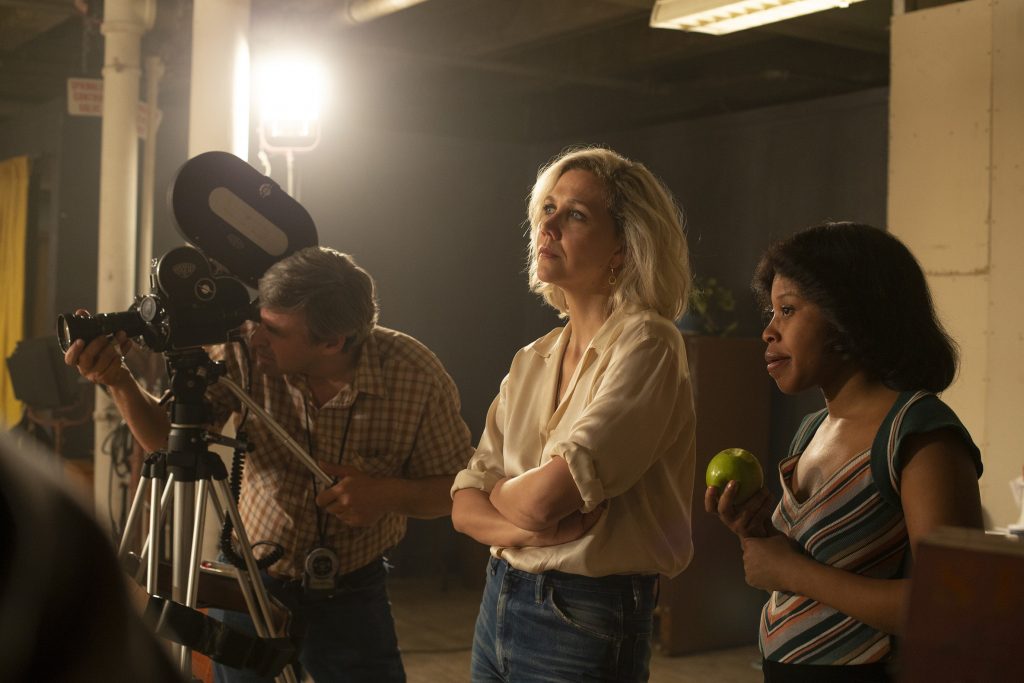Acting is a challenging profession. Amidst competing for roles, long rehearsal hours, and intensive dance routines, you might be surprised by what you see in the script once you finally secure an acting role. That’s where the role of the Intimacy Coordinator can help.
We’ve all watched contemporary television and films and attended plays, so we’ve become desensitized to the idea that a “sex scene” involves two actors. While engaged in the movie or show, we might see two characters exchanging steamy dialogue and physical contact instead of two professionals at work. From our perspectives, the chemistry of the two actors is paramount to a believable romance scene. Unbeknownst to us, it takes much more to carry out such scenes than good acting.
NYFA’s very own Nedra Gallegos, an instructor at the Los Angeles campus, sat down with faculty and staff to review the role and responsibilities of the Intimacy Coordinator. Our faculty and staff, who have years of professional experience as actors, writers, directors, producers, artists, and screenwriters, know first-hand the importance of communication when building a team.

What is an Intimacy Coordinator?
As defined by the Screen Actors Guild – American Federation of Television and Radio Artists (SAG-AFTRA), an Intimacy Coordinator is “an advocate, a liaison between actors and production…in regard to nudity and simulated sex and other intimate and hyper-exposed scenes.”
The fundamental functions of an Intimacy Coordinator involve their role as an advocate or liaison between the actors and production, ensuring performers and other production personnel adhere to safety protocols. It’s important to remember that while the Intimacy Coordinator might seem like a stuffy administrator, there only to stifle one’s creative vision for a project. The reality is they are the opposite. The role of an Intimacy Coordinator is not to suppress but to serve as an additional resource in realizing the director’s vision.
In essence, the Intimacy Coordinator facilitates an environment in which actors understand what is expected of them in hyper-exposed scenes and ensures there is informed consent. After the appropriate setting is established, the actors have a structure in which to unleash their performance in a way that they know is safe and comfortable.
When do you hire an Intimacy Coordinator?
If your film or project includes any of the following, you will want to hire an Intimacy Coordinator:
- Scenes with simulated sex
- Scenes involving simulated genital contact (above or below clothing)
- Scenes with intense kissing
- Scenes with simulated kissing
- Specialized movement, suggested movement (i.e., burlesque/strip-tease/lap dancing/group sex)
- Scenes involving sexual trauma
- Scenes depicting power dynamics or pre-existing relationships within the company that necessitate an outside eye
- If the director is not confident in handling a scene appropriately or navigating the actors in physical and emotional moments
The above is a sample of scenarios in which an Intimacy Coordinator is advisable. If your project or creative work includes scenes of sexual intimacy, violence, or scenes in which actors might be placed in uncomfortable moments for their character’s development, it is advisable to hire a licensed Intimacy Coordinator.
“The narrative may be fictional, but the contact is real.”
– Nedra Gallegos, NYFA LA Instructor
Codify It!
According to Chelsea Pace, an intimacy choreographer and author of the book, “Staging Sex: Best Practices, Tools, and Techniques for Theatrical Intimacy,” a good Intimacy Coordinator will use various vocabulary, best practices, and techniques to stage intimacy, nudity, and sexual violence. As we said before, these techniques aim not to desexualize a story but achieve the director’s vision in a way that is ethical, efficient, effective, and understood by all.
After the #metoo movement, many organizations, film studios, television networks, and theatrical playhouses took time to ensure they harbored safe environments for their employees. The importance of consent and facilitating a safe work environment across the entertainment industry has never been more pronounced or appreciated than today.

The Old Approach is no Longer Effective.
Even with the best intentions, directors can fall short of keeping the communication lines between actors open during rehearsals. Below is an example scenario that showcases the director’s “old school” methods of handling, followed by reasons why they are problematic.
This scenario was borrowed from the book “Staging Sex: Best Practices, Tools, and Techniques for Theatrical Intimacy” by author and intimacy choreographer, Chelsea Pace.
Scenario: Script and direction call for actors to “Just kiss each other.”
Old Approach #1: Talk it through, ask the actors what they think the characters would do with each other, and have them try it.
- Problem: This method narrows the emotional distance between the actor and character, making it less fictional and more natural–which is uncomfortable.
Old Approach #2: Send the actors to another room to act out the intimacy scene on their own.
- Problem: Actors, of course, want to please, be bold and take risks. This scenario could result in one or both actors feeling uncomfortable.
Old Approach #3: Show, don’t tell.
- Problem: The director is the power in the room, and actors are reticent to say no or vocalize their discomfort. As many actors know, many sets harbor a culture that implies “if you don’t do this, someone else will.” This culture suggests an actor is replaceable, leading to even more pressure for them to perform a scene in which they are uncomfortable.
The Casting Notice, Audition Disclosure Form, and Rider
Before the Intimacy Coordinator is brought onto the set, they first meet with the executive producer, writer, and director to discuss details of the script and intimate scenes involved. This conversation between a Coordinator and producer should include the degrees of nudity, specifics of simulated sex, and other important information a Coordinator needs to know about a scene.
The best way a director and producer can ensure they establish a role requires to clearly outline the expectations for what their project includes.
Below are examples that directors, producers, and staff can reference when outlining recruiting talent for their projects. Theatrical Intimacy Education provides an example casting notice, audition disclosure form, and rider that outlines what an actor is expected to do, a request for the actor’s consent, and questions to help an actor understand what they can expect should they accept a role.
How do I Find an Intimacy Coordinator?
Suppose you’re interested in finding an Intimacy Coordinator or intimacy professional for your project. In that case, you can check out the variety of Facebook groups dedicated to connecting creatives with professionals. The “I Need an Intimacy Professional (Facebook Group)” is one such group.
Are you interested in achieving training as an Intimacy Coordinator? You can go to Intimacy Directors & Coordinators for workshops and opportunities. Theatrical Intimacy Education (TIE) offers invaluable resources for those interested in learning more.
Don’t be afraid to incorporate all aspects of life into your project. Keep in mind the many facets of a healthy and consent-driven creative environment so that all actors, staff members, administrators, and spectators are safe and comfortable.